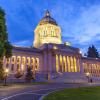 José L. Banda became superintendent of Seattle Public Schools (SPS) in July 2012. Fluent in Spanish, he holds a bachelor of arts degree from California State University in Bakersfield and a master’s in educational leadership from Chapman University. SPS serves more than 48,000 students in more than 90 buildings across Seattle’s neighborhoods. Go to k12.wa.us for more information about the district.
José L. Banda became superintendent of Seattle Public Schools (SPS) in July 2012. Fluent in Spanish, he holds a bachelor of arts degree from California State University in Bakersfield and a master’s in educational leadership from Chapman University. SPS serves more than 48,000 students in more than 90 buildings across Seattle’s neighborhoods. Go to k12.wa.us for more information about the district.
As superintendent, what do you see as your biggest challenge?
My biggest challenge is closing the achievement/opportunity gap while at the same time raising expectations for students meeting or exceeding standards.
While I truly believe it is possible to eliminate the gap, it will not happen without a focused, well-articulated plan for providing a challenging and rigorous curriculum for each and every student.
It will take effective leaders and highly qualified teachers, who are also culturally competent, to meet the needs of our diverse students. Finally, closing the achievement/opportunity gap will also require intentional and strategic partnerships with our diverse families and community partners.
Enrollment in Seattle schools has been increasing. How will the district deal with these rising numbers?
Seattle Public Schools expects an increase of more than 7,000 students in the next 10 years. For the short term, it will be necessary to add portables to certain school sites. School boundaries may be adjusted for the 2014–15 school year to address increasing capacity in certain areas of the district.
The district’s schools vary greatly in student achievement, school facilities and parent involvement. How do you envision improvements in these vital areas?
Two key levies that passed earlier this year will help us address the need for new and remodeled facilities to serve our growing number of students, as well as operations and maintenance of our current buildings citywide.
Closing the achievement gap continues to be a key focus, and implementing Common Core State Standards plays a major role in our efforts. These standards have been adopted by 48 states, including Washington, to provide consistent learning goals in English language arts and math.
In addition, we are putting the finishing touches on updating the district’s strategic plan, which will guide Seattle Public Schools for the next five years.
What would you like to see regarding standardized testing in the schools?
Standardized testing in schools is an important part of today’s educational landscape. We are responsible for ensuring that all students make progress from year to year — and over the course of their K–12 education.
As the new suite of assessments aligned to the Common Core State Standards come on board, we believe the assessment system will provide more timely feedback to teachers. Ultimately, we want assessments to be aligned to standards and provide information regarding our students’ progress that can assist us in determining how we can best help them succeed academically.
Some schools seem to have more technology resources. How important is technology in the schools, and what can be done to level the playing field?
Technology is an important part of every student’s education as we build their 21st-century skills. We have been fortunate in passing our capital levies, which fund the majority of the technology in the schools.
Most of the technology inequities between schools happen when schools directly receive grants or donations. There are some specific programs that have technology components that only exist at one or more schools, or a school may pilot a program that we are considering rolling out across the district. For instance, there is a STEM (science, technology, engineering and math) program at Cleveland High School where each student enrolled in the program receives a laptop that they use from their freshman year through graduation.
It is our hope to secure capital levy funds in the future to update the classroom devices (for example, smartboards) for all classrooms, but we have not been able to fund that conversion at this time.
Do you have ideas for ways to raise academic achievement in STEM subjects?
I believe it’s critical to provide each student with access to high-quality STEM instructional experiences by supporting teachers with effective professional development and STEM curricula. In addition to improving the quality of core instruction, attention needs to be given to student interest, aspiration and “identity” with STEM subjects and careers.
By age 11, most students have positive views of science in school, but by age 14, the majority has ruled out careers or pursuit of science. Without an identification or connection between STEM and their lives, their achievement then begins to decline.
How do you feel about the loss of diversity in some Seattle schools?
We believe that educational and racial equity is paramount to achieve educational excellence. Our goal is make sure that every one of our schools serves as a welcoming place in their neighborhood so that they engage students and families in learning. We are committed to closing the achievement gap and improving equity, access and opportunities for all students.
How can we improve teaching about race and racism?
Meaningful instruction about race and racism starts with providing the supports that our teachers need to embark on these conversations in a safe and empowering manner.
Our departments of curriculum and instruction and equity and race relations are working collaboratively to ensure that we first provide culturally responsive professional development for all of our teachers so that they can provide classroom instruction that is relevant to the cultural backgrounds of our students and families, so that they feel valued, respected and part of the community.
What is your approach to advanced learners and other special-needs student populations?
Seattle is committed to providing all students access to the general education classroom and curriculum. To accomplish this, the district and the Seattle Education Association have partnered to develop a service delivery model that is based on a student’s need, not his or her disability, and creates opportunities for students with disabilities to be educated with their typically developing peers.
As for advanced learners, we provide a range of services. Depending on qualifying test scores, students are offered placement in the Acceleration Progress Program, Spectrum or in some cases, they may elect to remain in their neighborhood school and receive services through our advanced learning opportunities.
How do you measure success?
I measure success by how effective we are as a school district at helping students succeed in every facet of their school lives. We need to ensure they receive a 21st-century education that will help them thrive in a global society and economy.










